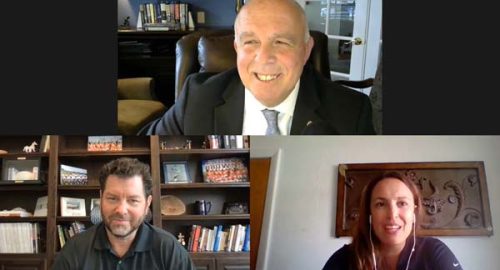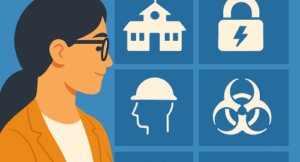The drastic increase in school violence does not surprise Chief Frank Kitzerow, President of the National Association of School and Campus Police Chiefs. “We’ve been having this conversation for well over a year and trying to figure out what it’s going to be like when students return to school. Unfortunately, the reality is hitting us very hard.”
Chief Kitzerow has 40 years of experience in law enforcement, including being the former District Police Chief with Palm Beach County. In a Raptor webinar, he shared strategies for how schools can prepare for and address increased violence on their campuses. A summary of the conversation is below. You can listen to the full webinar here.
Strategy 1: Anticipate Safety Issues
It’s important to be ahead of the increased violence and challenges, but to do this schools must pay attention to what is happening in their neighborhoods. “Our schools are a microcosm of our communities, neighborhoods, and nation,” Chief Kitzerow shares. “If you look at all the challenges that we’re having today as a society and all the impacts of the pandemic, you get a real feel for why these things may be happening [in our schools].”
“You have to get your key stakeholders around the table,” he continues. “It’s never ‘one-size-fits-all’ in school safety.” These stakeholders include law enforcement, staff, students, guardians, and safety organizations. Each will bring their perspectives into the conversation, which can inform the school of issues that are occurring outside and inside school buildings.
“The more we have people [involved in school safety], the greater the opportunity we have to turn this around and really make a difference,” Chief Kitzerow states. “These children are our future, and we have an obligation to give them every avenue of success.”
Strategy 2: Partner with Law Enforcement
“School safety and school districts work in one bubble. Law enforcement works in another bubble. They really don’t work together until something catastrophic happens,” Chief Kitzerow states. The more schools and law enforcement collaborate, the more successful their incident response will be, and the more lives they will save.
While there are many discussions about the appropriateness of police officers’ involvement in school safety, Chief Kitzerow reminds us that “policing in a school is way different than policing in our communities.” Traditional law enforcement officers are trained to respond to issues, resolve them, and then move to the next service call. School-based officers are more focused on problem solving, developing long-term strategies, and building relationships.
“Today’s environment is very, very difficult,” Chief Kitzerow acknowledges. There will always be community members who disagree with school decisions. Although schools should consider community feedback, it’s important to make decisions based on expertise and best practices. “We know what our mission is, and we need to constantly drive on that mission and keep things moving forward.”
Strategy 3: Collaborate with Mental Health Professionals
There is not one profile of a school shooter, but seeking revenge is a common motive. “Everything starts with a grievance,” Chief Kitzerow warns. “Many of these people who commit catastrophic events in our schools go up what we call a pathway of violence.”
This is why vetting every threat is incredibly important. “Mental health professionals are really valuable in helping [schools] understand who is just making a threat and who is actually posing a threat,” Chief Kitzerow says.
While law enforcement is investigating and making sure the school is protected, mental health professionals begin addressing the student’s grievance. “If we’re successful,” he begins, “that catastrophic event never occurs, and we save all those lives.”
Strategy 4: Build the School Safety Ecosystem
When thinking about creating a school safety ecosystem, Chief Kitzerow recommends starting with taking inventory of your current tools and plans. Consider what challenges your school faces now and the potential challenges you may experience in the future. Think about the worst-case scenario of an active shooter and make sure you have what’s needed to prevent, prepare for, respond to, and recover from that event. Then, continue adding pieces to your ecosystem until you have everything needed to address all situations, even localized incidents like student fights or playground injuries.
The ecosystem should empower you to move quickly, as Chief Kitzerow warns, “The longer it takes you to isolate, eliminate, or neutralize the threat, the bigger chance of loss of life.”
Schools should leverage technology that allows incident commanders, law enforcement, and school staff to know emergency details in real-time. This transparency enables incident commanders, for example, to know how many students are injured, how critical their injuries are, and where exactly they need to send EMS.
Chief Kitzerow continues to advise schools to plan for reunification events. “You have to know where every student is, who is authorized to pick them up, and confirm that who picks them up is the exact person they’re supposed to be,” he says. “Then [you must notify] the other caregivers that the student was reunited.” This process can quickly become chaotic if you do not have a process or the tools to streamline the effort.
Protect Your Schools with Raptor
“I can’t think of anything more important than keeping our children safe,” Chief Kitzerow concludes.
Principals, teachers, janitorial staff, parents, students—everyone—has a role in school safety. While we cannot predict emergencies, we can prepare our schools for them. We can create schools where students are safe and feel safe, so that they can thrive.
With Raptor Emergency Management, schools can protect their students and staff and be in complete control during drills, active incidents, and reunifications. Schedule a personalized demo to learn more.





